If you find the prices of your local deck sander to be completely unreasonable and you’re thinking about sanding your deck yourself, then this guide “How to Sand a Deck Like the Professionals” could be exactly what you need to get that fantastic professional deck finish without the inflated prices…
Here’s what you need to know…
You can do this…
Learning how to sand a deck for the first time can be daunting, but it’s actually quite simple…
Don’t get me wrong, sanding a deck is hard work but it’s a simple step by step process…
It can have you questioning your life choices but nothing worth having comes easy…
So with that said…
Sanding a deck the right way is a simple step by step process that anybody can do…
And don’t forget that I’ve got your back, so don’t worry about it..
Just follow the process and you’ll be great…
In fact, your deck will look better than great…
Check this out…
This deck was finished with 3 coats of natural deck oil…
I sanded it back and stained it using the exact same process and the exact same sanders that I’m going to show you here…
Just follow along, I’ve got you…
Ok, now we’ve got the little pep talk out of the way, let’s get into it…
What deck sanding tools do you need to sand a deck?
You don’t need a lot of equipment if you want to sand your deck boards but there are some tools that you can’t live without if you want that professional finish…
- A belt sander
- An orbital sander
- Detail sander
- Sanding belts
- Sanding discs
- Impact driver
- Hammer
- Nail punch
- Ear muffs
- Dust mask
- Knee pads
- Industrial Vacuum cleaner
Before you get into sanding your deck, you really need to make sure you have the best sander for deck refinishing…
So let’s get into that right now…
The Best Sander For Deck Refinishing is…
I sand multiple decks each and every week, so I’ve tried a bunch of different deck sanders over the years…
And easily, the best deck sander is definitely the Makita 9403 Belt Sander…
This is the deck sander that I personally use…
The Makita 9403 allows you to strip the old coatings off your deck especially if you have slight cupping on your decking boards…
The belt sander is big enough to sand the deck boards but small enough to work the uneven boards…
This is pretty critical when it comes to sanding a deck…
Using a belt sander to sand your deck allows you to sand those sections of the deck that a big drum sander would miss…
If you have any type of cupping, and most decks do, you can employ my “Round House Method” to easily get those hard to sand sections…
Oh, you don’t know what the Round House Sanding Method is?
Don’t worry, I’ll go into that a bit later. All you need to know is that my special sanding techniques work so well with the 9043…
That’s why the Makita 9043 Belt Sander is the best sander for deck refinishing…
Now as great as the Makita 9403 is at sanding a deck, you’ll still need two other sanders for your deck sanding…
You’ll need an orbital sander to sand the edges and to smooth your deck…
And you’ll also need a smaller detail sander to get into those tight corners…
Let’s have a look at the orbital sander I use for deck sanding…
The Best Orbital Sander for Deck Refinishing…
I recommend getting an orbital sander like this Metabo SXE-450 Turbo…
This is the orbital sander that I use for sanding the edges and smoothing the deck…
An orbital sander like the Metabo is great because it has a 150mm sanding plate which makes it more stable when you’re sanding your deck…
The smaller 100mm sanders have a tendency to tip over and damage your deck…
And when you sand your deck using the special techniques that I use, this sander allows you to stay in control and not cause any damage to your deck…
A sander like this is perfect for my High Skii Sanding Technique…
This technique allows you to get into those uneven boards without having to level your deck and thin it down with the massive deck sanding machines…
Usually, the only way to sand a deck is to level it first and then sand it…
You could be taking off 3 to 5mm and causing your deck timbers to become weak and unsafe to walk on…
But a sander like this used with my trade secret sanding techniques, you’ll be able to sand your deck without making it weak and unsafe…
The larger plate makes it so much easier to control and you don’t have to push down as hard while you’re sanding…
This model also has a variable speed and a turbo switch to sand the deck even quicker…
I always sand decks in turbo mode and this sander just eats it up…
I have tried cheaper orbital sanders in the past and they burn out when doing the larger decks…
I’ve sanded well over 200 decks with the Metabo SXE-450 orbital sander and it’s never missed a beat…
Ok, now let’s look at sanding in those tight corners…
The Best Detail Sander For Deck Sanding…
To complete your deck sanding, you’ll need to get yourself a detail sander…
I use the Ozito Multi Tool with the sanding pad installed…
In all honesty, you can get away with a cheap detail sander because it will only be sanding very small sections of your deck…
I use this sander to get into those tight edges…
There’s not really anything else you need to know about the detail sander except for the fact that you need one…
Once you’ve got your sanders, you’ll need to make sure you get the right sandpaper for sanding a deck…
Let’s get into it…
What grit sandpaper do you need for deck sanding??
To sand a deck properly, you’ll need a combination of 40 grit and 80 grit sandpaper…
You start off by sanding your deck back to bare timber with a 36 or 40 grit sandpaper…
This is where a lot of homeowners get a little scared…
People think that if you use a 36 to 40 grit sandpaper that you’ll chew up your decking boards and completely destroy it…
The truth is, as long as you have hardwood timber, you won’t…
If you’re sanding a treated pine deck then go with a 60 grit sandpaper but to sand any type of hardwood deck, you’ll want 36-40 grit on your belt sander to strip it back…
So get yourself some quality sanding belts like these Diablo sanding belts…
How much sandpaper do you need for your deck?
A packet of 5 like this will get you 5 metres squared of sanding…
Don’t try to skimp on the sanding belts and use them longer than you need too…
Do you want a thousand dollar quality finished deck or do you want to save $20 on sanding belts?
Divide the square metres of your deck by 5 and that’s how many packets of 40 grit sanding belts you’ll need…
Spend the extra money, you’ll thank me later…
Next we’re going to sand the deck with 80 grit sandpaper…
This is to smooth the deck before painting or staining…
For this, you’ll want some 80 grit sandpaper discs like these from Diablo…
Never go finer than 80 grit sandpaper when sanding a deck…
If you go too fine with your sandpaper, it closes the surface of the timber and the oil or stain you use can’t penetrate the deck boards properly…
Sanding your deck with 80 grit gives it the balance between smoothness without closing off the surface…
It’s the perfect environment for the deck stain to be absorbed…
Don’t listen to what those guys at the hardware store say…
They don’t know what they don’t know…
I have nothing against them but If they knew how to sand a deck properly, they wouldn’t be working at the hardware store…
Stick with the 80 grit sandpaper and give your deck stain the best chance to absorb into the boards…
You’ll also need 80 grit sandpaper sheets to match whichever orbital sander you have and hit the edges with the 80 grit as well…
How many sanding discs will you need?
You’ll need to use around 1 packet of 10 discs for each 10m2 of decking…
So work out how many m2 your deck is and then divide that by 10…
For example…
100m2 deck divided by 10 = 10.
So you’ll need 10 packets of 10 sanding discs for a 100m2 deck…
Make sense?
Now let’s get into how to use the sanders properly…
The 7 steps to sanding a deck like a pro…
Now that you’ve got the equipment you need, let’s get into the actual step of sanding a deck…
- Make sure your deck is clear from dirt and debris…
- Punch down the nail or screw down the screws before sanding…
- Sand the deck with a belt sander…
- Get the edges with an orbital sander…
- Get the tight sections with a detail sander…
- Sand and smooth the deck with the orbital sander…
- Vacuum the dust from the deck…
1. Make sure your deck is clear from dirt and debris…
We want to make sure that all of the dirt and stones are all swept off your deck…
The reason is, if you start to sand your deck and your sander runs over stones or debris, you can shred your sanding belts to bits…
So make sure you sweep your deck first before you start sanding…
That’s pretty straight forward so I think we’ll move onto step 2…
2. Punch down the nail or screw down the screws before sanding…
This part of sanding your deck can be a real pain in the you know what but it’s completely necessary…
If you sand your deck with the nail sitting up, you’ll sand the head straight off the top of your nails or you’ll chew up your sanding belts and make the job really hard for yourself…
So grab your nail punch and knock down each nail until it sits just below the surface of your decking boards…
Now, if you have deck screws, you’ll need to use an impact driver and the right drill bit to fit the head of your deck screws…
I use the Makita brushless impact driver…
Then go around and drive each screw just below the surface of your deck…
If the screws aren’t driving down, the best thing to do is to drive the screws out a little bit first and then drive them back in…
That’s the best way to do it without destroying the heads on your drill bit or the head of your screws…
Another thing to keep in mind with your nail punch, you want to get the punch to be just smaller than the head of your nail…
If it’s too big, you’ll make big holes in your deck…
And if it’s too small, you’ll damage the head of the nail…
So make sure you get the right size for your nail head…
I normally use a thicker punch when I sand a deck…
Once you’ve done every nail or screw on your deck, it’s time to start sanding…
3. Sand the deck with a belt sander…
It’s pretty easy to learn how to sand a deck with a belt sander…
First you want to make sure you know how to turn it on and lock it so you can let go of the trigger…
If you hold the trigger for a long period, your forearms will be screaming at you so pay attention, I’ll show you how easy it is…
See this here…
This is the trigger you pull to start the belt sander…
While you’re pulling the trigger, click this button down…
That’s the lock to keep the belt sander running even after you release the trigger…
Now let’s install the sanding belt…
Make sure the sander is off and then pull this lever out like this…
This allows you to slide the sanding belts on and off…
Now slide the sanding belt into place like this…
And push the lever back into place to lock the sanding belt in…
The next step is to make sure the belt is running in line with the sander so what you want to do is, hold the sander up and pull the trigger…
You’ll see the belt start to move into place…
The belt should line up with the slip pad like this…
If it’s not lining up then you need to turn this knob here until you get it to line up…
This knob here…
Now you’re ready to start sanding your deck…
Make sure the belt sander is off and not spinning then place it flat on one of the deck boards…
When you pull the trigger, the belt sander will try to run forward…
You just need to make sure you’re holding it by this handle and it won’t go anywhere…
Lock the trigger in then place your other hand on the handle…
You want to work the sander up and down the length of the boards, and not across…
The sander will do most of the work but you can apply a little pressure downward to help it out a little…
It’s usually at this point that you discover sections of your deck are actually uneven and warped out of shape…
This makes removing all of the old stain and surface damage an almost impossible job…
The thing is, even if your boards look flat and even, they usually aren’t…
Think about it…
Your deck sits outside in the rain and sun, with the constant wetting and drying, expanding and contracting…
Don’t panic, this is the case in 9.9 out of every 10 decks that get sanded…
I come across this everyday…
That’s why I created my very special RoundHouse Sanding Method and High Skii Techniques to get the sander to reach inside the cupping and to get into all of those low spots…
Before I discovered my method, it was almost impossible to properly sand the middle section and low spots…
And if you don’t sand your deck properly, the colour will look dirty or possibly patchy once you stain it…
Check this out…
This is a customers deck after they attempted to sand it then applied a coat of stain…
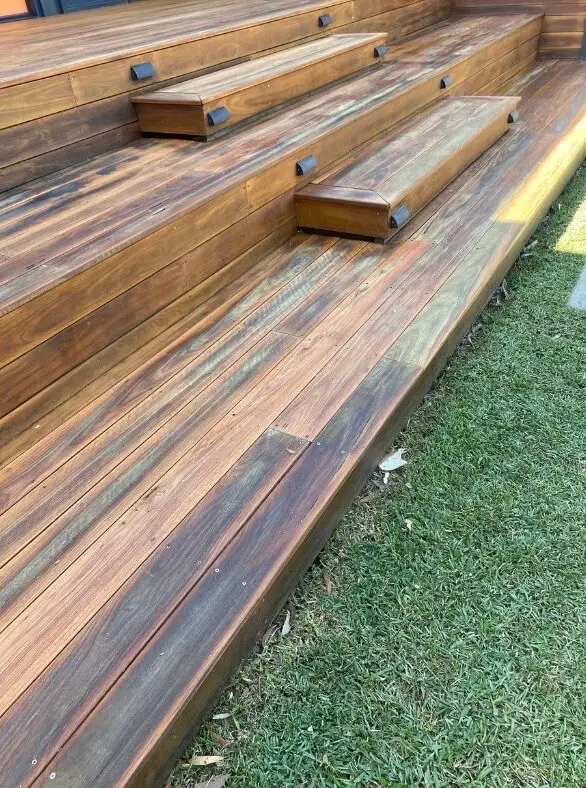
You can see how they weren’t able to sand the middle of the boards properly…
The sander couldn’t quite get in there…
They obviously didn’t know my RoundHouse Method or High Skii Technique…
And as you can see, a fresh coat of deck stain won’t hide a bad sanding job…
Now, as bad as this look, the real problem is that the middle section of the boards won’t absorb the deck stain properly and it’ll peel and flake in those sections…
You need to make sure you get right into every cupped board, every warped and uneven section or your deck is peeling in a couple of months…
If you want me to show you how to sand your deck properly using The RoundHouse Method and High Skii Technique, click here and I’ll show you what you need to know…
Once you’ve got the technique down properly, just keep going until you’ve completely sanded and stripped the deck back to raw timber…
Did you notice that I couldn’t get to the edges with the belt sander?
That’s why we have step 4…
4. Sand the edges with an orbital sander…
This is where you use your orbital sander with the 40 grit sanding discs…
The idea is to keep the sander flat to the deck and work it around until you remove the old coating from your deck…
Just keep sanding until all of the edges are sanded back…
If you come across any sections that are uneven, you’ll quickly realise that keeping the sander flat, just an’t gonna cut it…
That’s why I created the High Skii Sanding Technique…
You just need to be careful, because if you do this wrong, you could etch divots into your decking…
Once the bulk of the sanding is done, you’ll come across some sections that you can’t sand with the orbital sander…
This is why you also need your detail sander…
5. Get the tight sections with a detail sander…
Use the detail sander to get into the tight corners…
You can move the disc around to make it easier for yourself to get right into the corners of your deck…
When it comes to the detail sander, I prefer to use an 80 grit sandpaper instead of the 40 grit…
The 40 grit sandpaper seems to scratch the deck more than sand it, besides, with a small section of decking, it’s easy to sand with 80 grit sandpaper…
So now that you’re done with the detail sander, your deck should be completely sanded back to raw timber…
But we’re not finished yet…
We still have to smooth the deck before we call it a day…
6. Sand and smooth the deck with the orbital sander…
Now what we’re going to do next is to grab the orbital sander again but this time we’re gonna use the 80- grit sandpaper instead of the 40 grit…
The whole idea is to smooth the surface of the deck and remove any sections that we missed with the belt sander…
All you need to do is run the orbital sander up and down the boards until it feels smooth to touch…
Remember that your aim at this point isn’t to strip the deck back, it’s simply to smooth it off, so it shouldn’t be a hard job…
Run the sander up and down over each board and that should be all you need…
Now your deck should be completely sanded…
The only thing left to do now is to…
7. Vacuum the dust from the deck…
This step is pretty important if you have any intention of applying a deck stain or oil…
You can’t apply any type of deck coating if your deck is covered in dust…
So get out your industrial vacuum cleaner and treat your deck like it’s your living room and vacuum that sucker…
Make sure you vacuum between all of the boards and in all of the corners…
Do it properly, don’t act like a teenager and pretend you vacuumed…
Come on now…
We’re all adults here…
Ok good…
Now before you move on…
Here’s a couple of deck sanding techniques that’ll make your deck sanding a whole lot easier…
I’ve been doing this a loooong time…
Just over ten years to be exact…
Now, I know better than anybody how tough it is sanding a deck with the belt sander and orbital sander combo…
But I still do it this way, because it’s the best way to do it…
Here’s the thing…
For me to make any money in this business, I need a couple of things to happen…
I need to get the job done as quick as possible so I can move onto the next job…
And I also need the deck sanded back properly otherwise the finished deck will look blotching and most likely peel within a couple of months…
And that’s bad for business..
In fact, if I was handing over blotchy decks that peel within a few months, I wouldn’t have a business…
But I’ve got a couple of secret weapons to make sure I get the deck sanded as quickly as possible and as thoroughly as possible…
It’s two very simple sanding techniques that I use together to sand back even the most bent out of shape decks you could ever imagine…
I get in there with my two simple techniques and I sand that decking back to bare timber in record time…
The techniques I use, cut through old deck stain like a knife through butter…
If I’m being honest, you can’t sand a deck back properly without using these techniques…
There’s always sections on your boards that can’t be reached properly with traditional sanding methods…
If your deck is cupped, uneven or has any type of warping, your sanders will not strip your decking back enough to absorb the stain properly…
That’s why I developed my very special sanding techniques…
I call them The RoundHouse Method and The High Skii Technique…
You may have heard me talk about them before…
Well, if you want to learn them for yourself, click this link here and I’ll show you what you need to know…
Congratulations! Now you know how to sand your deck…
Now, it’s at about this point that most homeowners start to freak out…
And I have to talk them off the cliff…
It goes a little something like this…
“I don’t know about this, this seems like a lot of work!!”
“Can’t you just do it for me??”
“How long is this going to take to sand a deck??”
Calm down, take a deep breath…
Your answer is in the next part of this guide…
Let’s get to it…
How long does it take to sand a deck?
In general, it will take you 8 hours to sand a deck that is 25m2, using a belt sander. But there are a few factors that can affect the time it takes to sand your decking.
There are 3 main things that will affect how long it takes to sand your deck…
These are:
- The condition of the coating on your deck
- The type of sander you’re using
- The size of your decking
The Condition of the Coating on Your Deck
If the current coating on your deck is in pretty good condition like this…

Then it’s actually easier and quicker to sand your decking.
If your current coating is like this…
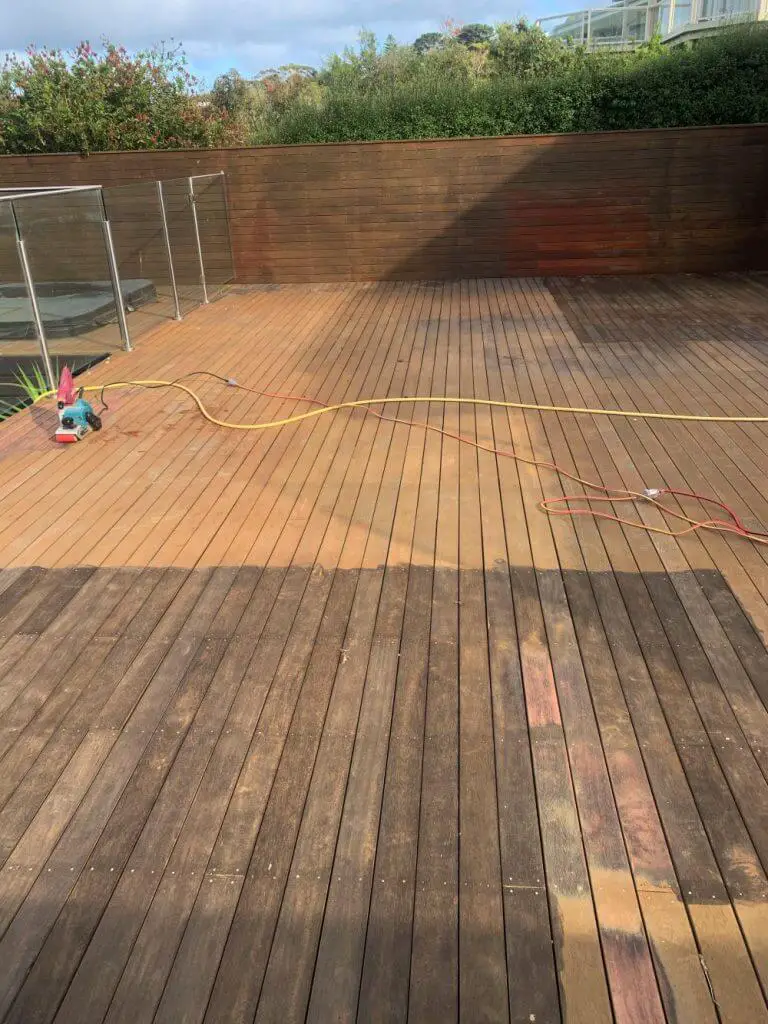
It’s actually a lot harder to sand…
When you sand a decking with a coating that is in good condition you’ll find that it comes off easily and you’re left with timber that looks brand new…
But a decking that is faded and missing in spots has two layers….
You’ll sand off the top faded coating then you’ll be left with a grey or black coating which is damage from the weather…
You’ll have to sand this off as well, but it takes a little more “elbow grease” to remove this grey damage.
If you don’t sand it off properly then your deck will look black and blotchy.
You can see what I’m talking about from the photo below…
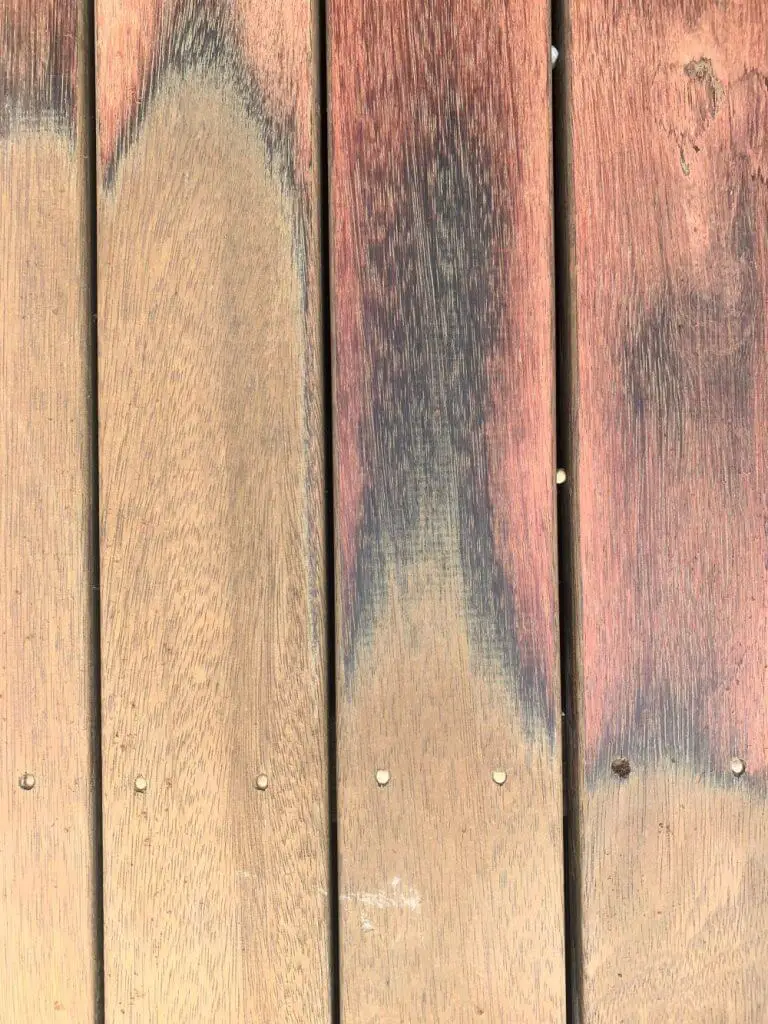
If your decking looks like this, it’ll take you more time to sand your decking back properly.
The Type of Sander You’re Using
If you’re going to get down there yourself and sand back your deck, then you’ll probably be wanting to use a belt sander for the bulk and an orbital sander for the edges…
Not all sanders are created equal…
The sander you use can drastically affect the time it takes to sand your decking…
By now you k now that I recommend this belt sander from Makita…

But if you don’t want to spend that much I would recommend checking out something like this Ozito for $99

Something like the Ozito could be fine for a one off small deck but it would be a lot quicker with the top range Makita sander.
I’ve found these cheaper tools get the job done but they’re not as effective as the Trade quality tools…
It’s at this point that most people consider just hiring a big sanding machine to make life so much easier…
You could always hire a stand up Orbital sander to get the job done, but…
The problem with the bigger, stand up sanders is that a lot of the times your decking boards will have slight cupping…
Or decking boards that are sitting uneven…
You probably won’t even notice it until you start sanding…
And when you use a big sanding machine, it can’t reach any uneven sections or cupped boards…
So the only way to sand a deck properly with a big floor sander is to sand across the boards first to level it off and then sand up and down the boards to smooth it off…
The problem with this is, most decking boards are only 19mm thick…
And when you sand across the boards and then up and down the boards, you could be removing 5mm from your 19mm boards…
This means that your decking boards will now be only 14mm thick…
That doesn’t sound very safe to me…
The thing is, most deck sanding companies won’t tell you this but, you can only sand your deck twice before you need to replace the boards…
Because, what happens in 2 years time when you need to sand your deck again?
Will you take another 5mm off the top leaving you with only 9mm to walk on??
That’s why I only ever sand a deck using a combination of my “gentle sanding techniques” namely the “RoundHouse Sanding Method” and the “High Skii Technique”
These techniques together allow you to sand every section of your deck evenly without weakening the boards and making it unsafe to walk on…
Plus you won’t have to pay thousand of dollars to replace your entire decking because you weakened the boards to unsafe levels with a floor sander…
It’s hard to sand these boards properly with these big sanders. It’s a lot easier and more effective to use a belt sander with the RoundHouse Sanding Method and The High Skii Technique…
Choice is your…
But before you move on, there’s something else that affects the time it takes to sand your deck…
And that is…
The size of your decking…
Of course the size of your decking will affect how long it takes you to sand your deck.
I’ve found that I can sand about 25m2 of decking in a day…
So if your decking is 50m2, it could take up to 2 days…
But if you aren’t used to sanding deckings, it can be a painful task that will have your knees aching… your back screaming… and your abs cramping…
You may need more regular breaks to allow your body to recover…
It could double the time it takes you to sand your deck…
If you do sand the deck yourself, make sure you get some knee pads…
The cheap ones will work pretty good if you’re using them just for your deck…
As you can see, there’s quite a lot of work that goes into sanding a deck…
You might even start thinking about how you can speed the sanding process up…
How about sanding a deck with a floor sander?
Did you into just read what I wrote earlier about floor sanders??
Ok, just in case you skipped down to this section, let me go over this again…
If you want to speed this up, you might be tempted to hire a floor sander to sand your deck…
In most cases, using a drum sander or floor sander to sand your deck is a bad idea…
The first reason is, even if your deck looks pretty flat, it usually isn’t…
And when you use a floor sander to sand a deck that isn’t perfectly flat, it won’t sand every part of the boards…
You’ll be left with half your board sanded and half your board not sanded…
The second reason is, most floor sanders aren’t designed to sand a deck…
And the moment you hit any type of deck nail or screw, you’ll damage the drum…
Wherever you hire your floor sander from will charge you to repair or replace the damaged floor sander…
There is actually a rental company who stopped renting out floor sanders for this reason…
Click the blue link above to see what they say about sanding a deck with a floor sander…
It’s pretty much because they don’t recommend homeowners to use floor sanders on their deck…
So in most cases, don’t even consider using a floor sander to sand a deck…
Instead, learn my secret deck sanding techniques, and use a combination of the belt sander and an orbital sander…
Still not convinced?
Check this out…
I used an Orbital Floor Sander to sand a deck and this is the results…
The picture below shows the difference between an orbital floor sander and a belt sander when sanding a deck…
The left of the picture is the deck with no sanding…
The middle is the orbital floor sander…
And the right section is the Makita belt sander…
You can judge for yourself which sander works best…
Now with all that said, most of the professional deck restorers use a drum sander to sand a deck…
So it can be done and if you know what you’re doing, it could be an easier option…
It’s just not the best option, or the safest option or even the most cost effective option when you think that you could possibly weaken your boards to the point of needing replacement, but just in case you still wanna use a floor sander, this is for you…
How to use a drum sander on a deck…
The whole idea with a drum sander is to level your deck off first…
To do this you need to sand across your deck on a 45 degree angle…
Once it’s level, next you need to sand along the length of the boards…
This can be a tricky way to sand a deck if you don’t know what you’re doing, so I don’t usually recommend it…
If I was you, I’d stick with the belt sander and orbital sander and pair that up with my special “RoundHouse Sanding Method” and the “High Skii Sanding Technique”…
That’s the best way…
Now you know how to sand a deck, what’s next??
Well my friend you did it…
Your deck is completely sanded and it’s ready for the next step…
Should you paint your deck or should you stain it?
What that step is, really depends on how you want your deck to look…
You can leave it and let it grey off, or you can give it a coat or 3 with deck oil or stain…
If you want to know how you can stain your deck check out my guide…
Just click the blue link above and I’ll take you straight to the guide…
But either way, that’s the topic of another blog post, not this one…
So I’m going to leave it right there…
I hope I’ve been able to answer all of your questions today about how to sand a deck…
That’s about all from me for today…
Peace,
Jason
Need some Expert Advice?
If you’ve been searching the internet trying to find an answer to a specific deck problem and you’ve found it impossible to get a straight answer…
Why not just reach out and ask me directly for an answer?
I’ve got 10 years of deck knowledge crammed into my noggin. I can pretty much guarantee I’ve got an answer to your problem just rattling around in there…
Click the button below to find out more…
FAQ’s
If you want to sand your deck fast, here’s what you need to do. Get a Makita 9403 Belt sander and some high quality 36 grit sanding belts. If you have a 25m2 deck then get any least 20 sanding belts. If you have lots of belts, you won’t have to keep sanding when the belts are worn down. If you sand a deck with worn out sanding belts, it can take twice as long…
The best sander for deck refinishing would definitely be the Makita 9403. The size allows you to sand those cupped deck boards. The power and the weight make it faster and easier than any other sander I’ve used to sand a deck…
Yes, you can definitely use a belt sander on a deck. Using a belt sander on a deck is one of the best ways to sand a deck. Just make sure you sand in the direction of the timber. Don’t sand across the deck or you’ll leave huge divest and scuff marks all over your deck…
If your deck is old and worn or if you have peeling deck stain then yes, you should sand your deck before staining. If you have pressure washed your deck and have raised timber fibres on the surface, then you will also need to sand your deck before staining. If you are simply restraining a stained deck then you won’t need to sand…
To sand your deck, use a belt sander with 36 to 40 grit sandpaper belts to strip and remove the old surface and deck coatings. Next you’ll need an orbital sander with 40 grit sanding discs to sand the edges of your deck. The tight spots will need to be sanded with a detail sander. Once your deck is completely sanded, use an orbital sander with 80 grit sanding discs to smooth your deck ready to stain. That’s how you sand your deck…
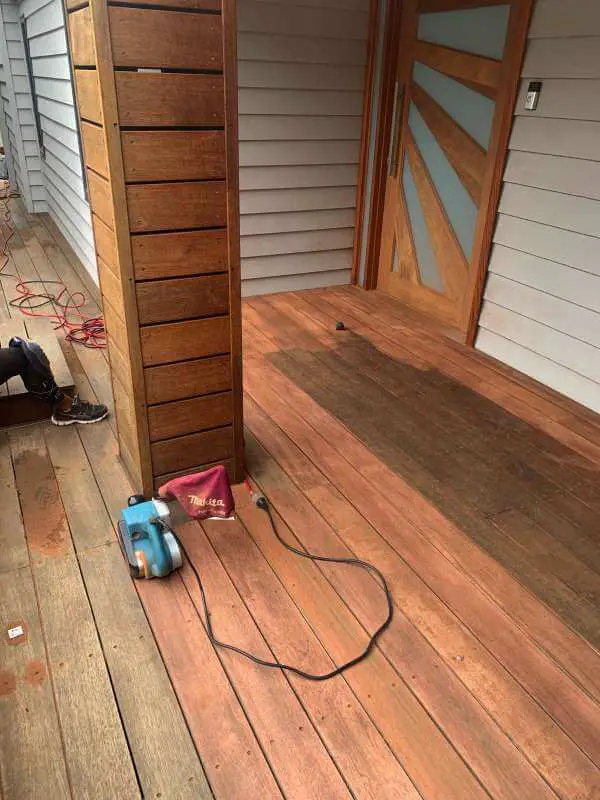
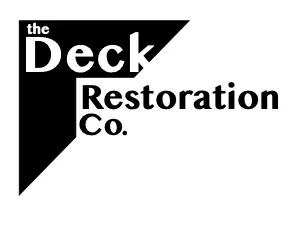
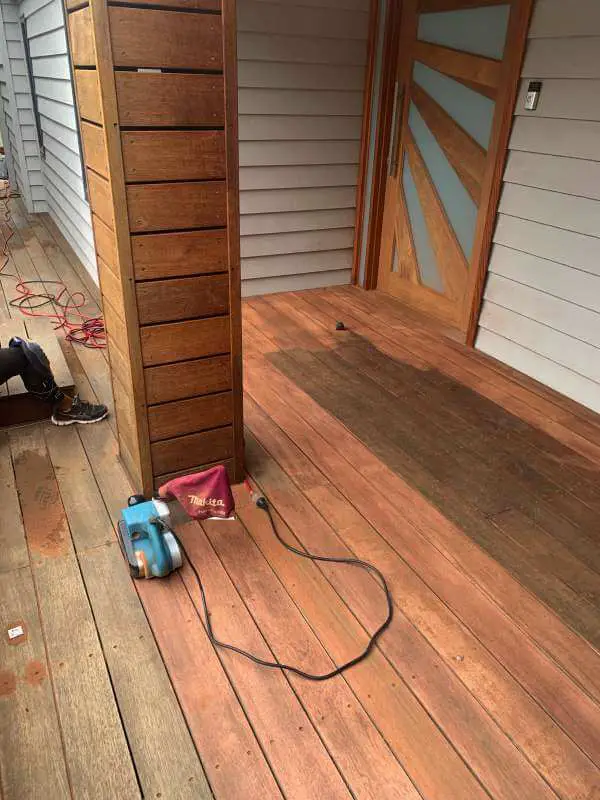
After reading this, I decided to just paint the damn thing!
Hi Dan, There’s definitely some steps involved but painting is one of the worst things you can do to a deck. The problem with paint is that it peels and bubbles but it’s much harder to strip off your deck than a stain or oil. And one thing’s for sure, you will eventually need to strip it off. If you paint it and then decide in a couple of years from now that it needs to come off, most deck restoration companies won’t touch it. Paint can be a real bugger to get off.
If you don’t want to sand your deck, it’s much better to use a chemical stripper instead and then oil your deck but I don’t recommend painting it.
I read this article several times, and I can’t find an actual description of the roundhouse method. What exactly is the roundhouse method?
Hey Bill, I was just in the process of creating a page for The RoundHouse Method…
Here’s the link: https://deckrestorationco.com.au/roundhouse-method-high-skii-technique/